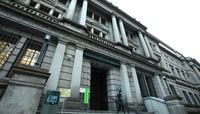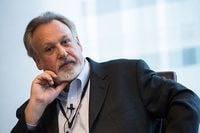The Bank of Japan (BOJ)’s October 30 decision not to ease further has caused great disappointment among BOJ-watchers. JPMorgan, which had expected the BOJ to make a move, now thinks it will take another year, unless the inflation situation deteriorates markedly before then.
“The Bank is now more backward looking, not preemptive like in October last year,” JPMorgan stated.
In other words, the BOJ is now reacting to events and thus will not likely move until after inflation actually decelerates rather than moving in advance to prevent that from happening.
That’s a problem because current leadership has track record of being over-optimistic: two years ago, the BOJ said it would have already achieved 1.9% “core inflation” (ex-fresh food) by this year; now, it says that core inflation this year will be just 0.1%.
Even some of the members of the BOJ's own Policy Board question whether the 2% target will ever be reached during Governor Haruhiko Kuroda’s first term, which ends on March 31, 2018. The median projection of the nine Policy Board members is that core inflation will reach 1.8% during fiscal 2017 (which ends March 2018).
However, according to the Bank’s “Outlook” report, five out of the nine members believe that the risk is that inflation will be lower than that. Moreover, among all nine members, the estimate was a 30% risk that inflation would be lower than 1.5%. The good news is that no one on the Board expects a return to the outright deflation that plagued Japan from the mid-1990s onward.
There is a basic problem with Kuroda’s strategy. He believes that monetary ease is both necessary and sufficient to achieve 2% inflation. In reality, monetary ease is necessary, but it is not sufficient.
Put 30 gallons in 15-gallon tank
Kuroda is like a car mechanic who tells you that, since cars need gasoline to run, he’s going to put 30 gallons of gas in your 15-gallon tank. “But, Kuroda-san,” you say, “The transmission is also broken.” In that case, he says, “I’ll make that 60 gallons.”
The key missing link in his strategy is the labor market. Kuroda claims Japan is at full employment and this should cause wages and prices to rise. In reality, the last time Japan’s core inflation (all items except food and energy) hit 2% was when the unemployment rate was below 2.4% back in the early 1990s. Based on the trends from 1991 onward, today’s unemployment rate of 3.4% tends to yield an inflation rate of around 0.5%.
Similarly, Kuroda has taken to lecturing companies that they should raise wages more than they have. “Unless there's balance throughout the economy, with wages growing and corporate profits rising, too, it will be difficult to achieve the 2% [inflation] target in a stable manner,” he said in an Osaka talk.
Yet, data from 1991 onward shows that, in order for nominal wages to rise at least 2% per year, the unemployment rate would have to drop to 2.6% or even lower.
The problem is that the BOJ by itself has no tools to lower unemployment. Monetary ease can lower unemployment when the BOJ is able to lower interest rates and when that leads to more purchases of houses and cars as well as capital investment by companies. That does not work in an era of near-zero interest rates.
These days, the most powerful path to bringing down unemployment would be fiscal stimulus. Yet, Kuroda insists that the government do the opposite: raise taxes and cut spending. Kuroda warns that more deficit spending would raise Japan’s government debt.
But the fact is that the BOJ is buying so many JGBs that government debt owned by everyone except the BOJ have already fallen from 152% of GDP in 2011 to 129%, and that figure will keep on falling.
In economic policy, one must not only do the right thing, but do it in the right order. The watchword should be: recovery first, fiscal consolidation after that. Fiscal policy should be used to lower unemployment, while monetary policy is used to buy the resulting government debt.
Former US Federal Reserve Board Chairman Ben Bernanke proposed just that sort of fiscal-monetary partnership in a 2003 speech in Tokyo. It is still the right policy.



